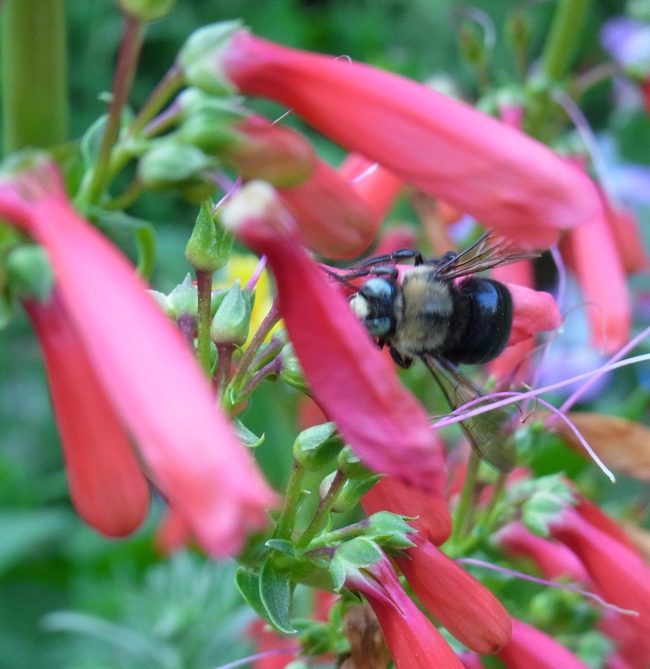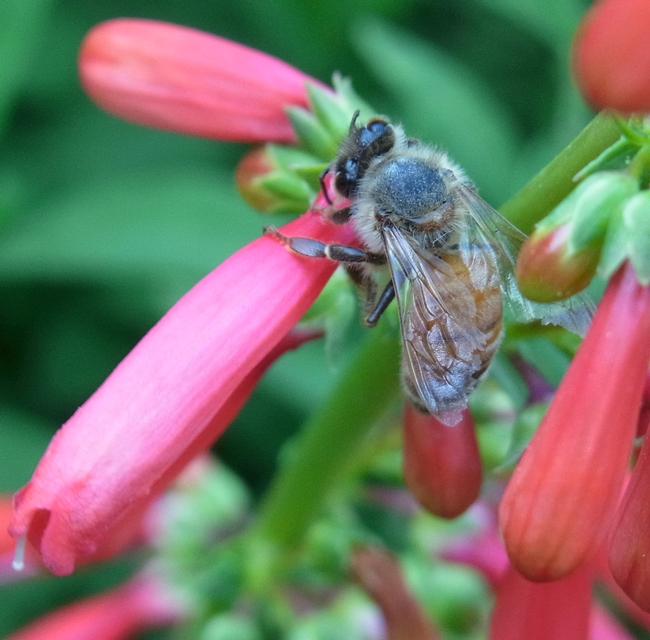- Author: Christine Casey
As we move into the heat of the summer, few plants show their value as bee plants for hot, dry gardens better than the salvias. Known by both their common name, sage, and their genus name, salvia, we have a tremendous number of these plants in the Haven for good reason. No bee garden should be without a salvia!
For gardeners interested in learning more about this group, two books are recommended. Long-time salvia fans will be familiar with The New Book of Savias: Sages for Every Garden (2003) by Betsy Clebsch. Newly published is The Plant Lover's Guide to Salvias by Northern California nurseryman John Whittlesdy. This book updates gardeners on many of the new species and cultivars in the trade and has great color photographs, including some with bees.
Salvias in the Haven
Here is a sampling of the salvias planted in the Haven. A complete garden plant list is here. Salvias do best in full sun, but can take partial shade (although flowering will be reduced). They need well-drained soil and little water, except as noted below. Most do best when cut back hard in the fall (except for the winter-bloomers, which should be pruned after flowering).
Cleveland sage, Salvia clevelandii. This uniquely-scented plant is a favorite of both bee and human visitors to the garden. A California native, it has soft grey-green leaves and purple flowers that bloom from May until late summer. There are a number of cultivars and hybrids with other native sages, many of which are only available through specialty nurseries and plant sales. Two that are most commonly used in gardens are the cultivars ‘Allen Chickering' and ‘Winifred Gilman'. Both are becoming more common in garden centers as customers look for drought-tolerant plant options. ‘Allen Chickering' grows to about five feet tall and wide, while ‘Winifred Gilman' tops out at about three by three. ‘Winifred Gilman' also has the deepest purple flowers of the group.


Brandegee's sage, Salvia brandegii. One of my personal favorites, this California native blooms from January through May and intermittently the rest of the summer. It provides vital early-season forage and is a bee favorite. Textured leaves add to its interest. It reaches about three feet tall with a spread of at least twice that. The cultivar ‘Pacific Blue' has lavender flowers while the species has white flowers.

Hummingbird sage, Salvia spathacea. Pineapple-scented leaves and bright pink flowers make this California native salvia a standout in the garden. More tolerant than shade of most sages, this is a good choice for planting underneath native oaks that cannot have summer water. Unlike other sages, it spreads by underground rhizomes and will colonize a large area.
Autumn sage hybrids, Salvia greggii; Salvia greggii x microphylla; Salvia hybrida. I couldn't begin to do justice to the diverse members of this group in one blog post. A few of the best performers at the Haven are ‘Hot Lips' (red and white flowers); ‘Lipstick' (red flowers); ‘San Carlos Festival' (bright pink flowers); and the Heatwave series (several flower colors).

Bog sage, Salvia uliginosa. Unlike most sages, this one needs regular moisture and part shade. At the Haven we grow it near one of our bee waterers to provide this; I've also grown it as a container plant. Tall flower spikes with light blue flowers distinguish this bee favorite, which can spread vigorously with the right conditions.
- Author: Christine Casey
National Pollinator Week is here! If you like to eat, thank a pollinator. Honey bees and dozens of species of native bees are hard at work right now creating the fruits, nuts, and vegetables that make our diets nutritious and flavorful.
And when they're not working food crops, they are busy pollinating the plants that wild animals rely on for food and shelter.
Celebrate with us this week at the Honey Bee Haven's open house on Friday, June 20, from 5:30 to 7pm. We'll have free zinnia seeds for all visitors while they last, honey tasting, and informal tours with experts available to answer your bee and plant questions.


To learn more about National Pollinator Week and the amazing bees, here are a few web sites that may be of interest:
National Pollinator Week at the Honey Bee Haven
Learn more about bees: Xerces Society for Invertebrate Conservation
Bee gardening: UC Davis Häagen-Dazs Honey Bee Haven and UC Berkeley Urban Bee Lab
The University of Florida's Native Bee Nest Site project
Pollinator Week flyer
- Author: Christine Casey
“How many plants do I need?” “How should I space my plants?” are two of the common questions we hear at the Honey Bee Haven when visitors ask about designing their bee gardens. Among the factors ecologists use to evaluate how bees use a floral resource are patch size, floral diversity, and floral density.
Patch size is the area covered by the desired resource (flowering plants) in a habitat that is fragmented. Floral diversity is the number of different species of flowering plants in an area, while floral density is the number of flowering plants in an area.
For honey bees, patch size is key. The scout bees return to the hive and direct their sisters to a good resource. Honey bees are efficient foragers that will visit many flowers on one plant until they have a full load of pollen or nectar. By grouping all plants of a species into a singe patch rather than spreading them around the garden you help honey bees maximize the value of each trip to and from the hive. There is no hard and fast rule for a minimum patch size, although three feet square is an area often recommended by bee biologists.
Bumble bees, on the other hand, tend to move quickly from plant to plant. So large patches of one plant species are less important than dense patches with a diversity of flowering plants.
At the Haven we have examples of both planting styles.
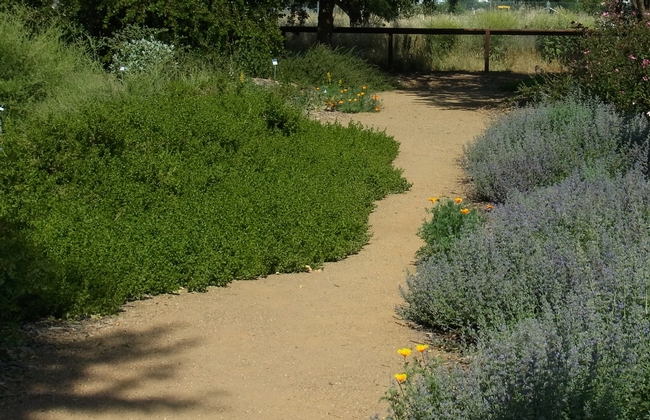

Getting back to the questions posed at the beginning of the post: rather than worrying that you might not have a large enough garden or be able to provide the right mix of plants, just do it! Choose plants that will provide flowers for as much of the year as possible, with as much of the garden as you can planted with flowers. In the Davis area, bees are active year round so the Haven always has something in bloom. If the garden does include turf areas, which don't provide bee forage or habitat, try to plant your flowers so that they are in a continuous patch.
- Author: Christine Casey
Many insects can obtain the water they need from their food. Bees, however, need to drink water. Honey bees use water to make honey and to cool the hive.
As the weather heats up, I thought I'd review some ways to provide water for bees in the garden. This is especially important in this drought year, as some typical water sources such as leaking faucets may not be available. This is what commercial beekeepers do; their “bee board” is just a fancy name for a board leaning underneath a slowly dripping faucet. This can be recreated in a more water-conserving way by placing a board under the faucet of a rain barrel. 

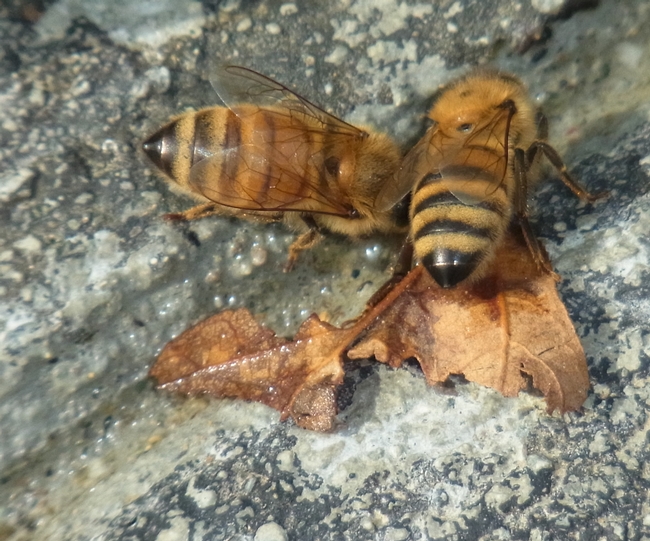
This year I've added a water source to the garden made from old soaker hoses. 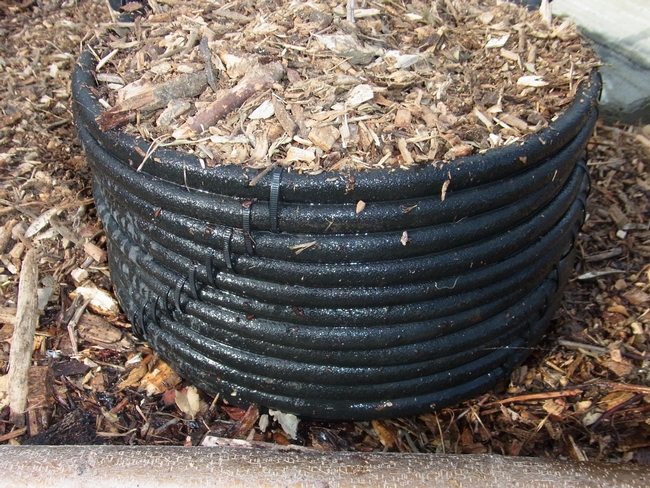
Here's how it's done:



- Author: Christine Casey
Bees need flowers that correspond to their body size and tongue length in order to effectively access the nectary located at the flower base, so a well-designed bee garden includes plants that provide a variety of flower shapes and sizes. Small bees with short tongues, for example, need a small, open flower like yarrow to feed effectively.
To further complicate matters, some bees have learned that they can access otherwise unavailable flower resources by nectar robbing. These bees have learned to chew a hole at the base of flowers; through this they insert their tongue into the flower to access a nectar reward they would otherwise be unable to reach. Since the insect never enters the flower there is no pollination, and ecologists are now beginning to study this behavior to determine if it impacts flower populations in the wild.
But that's not the end of the story. Clever honey bees will observe the larger bees creating holes and will use them as well. Nectar robbing is often seen on tubular flowers, and in the Haven we see it most frequently with carpenter bees and bumble bees on penstemon and salvia.


